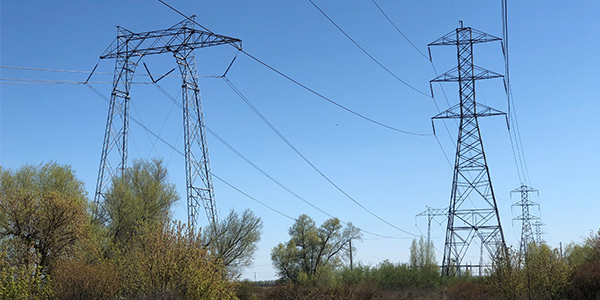A report released Wednesday by the National Association of Regulatory Utility Commissioners’ research arm says California and other states with decarbonization goals will need to use more advanced planning methods to ensure they have adequate resources while relying increasingly on wind and solar energy.
CAISO’s load-shedding orders on Aug. 14-15, which blacked out roughly 2.4 million residents during an extreme Western heat wave, prompted the report by the National Regulatory Research Institute (NRRI), titled “The Intersection of Decarbonization Policy Goals and Resource Adequacy Needs: A California Case Study.”
“The August events highlight the need for continued improvement to resource adequacy constructs, along with developing and implementing enhanced metrics to accurately assess an electric system that continues to be transformed by ambitious state decarbonization policies,” it says.
NRRI Principal Researcher Elliott Nethercutt and Chris Devon, director of market intelligence for Customized Energy Solutions, wrote the report. It largely addresses problems identified in the final root-cause analysis of the August blackouts issued jointly by CAISO, the California Public Utilities Commission (CPUC) and the California Energy Commission in January. (See CAISO Issues Final Report on August Blackouts.)
“According to the root-cause analysis, two of the three primary causal factors were related to resource planning targets that ‘have not kept pace’ with the changing resource mix, leading to insufficient resources available to meet demand during the early evening hours,” the NRRI report says.
California leads the nation in adopting renewable resources; wind and solar can meet more than 80% of demand on some days, the report notes. The growth in renewables has corresponded with the rapid retirement of natural gas generation, which CAISO operators dispatch to meet the steep evening ramp when solar drops offline, it says.

California needs dispatchable resources to meet its steep evening ramp, AKA the neck of the “duck curve.” | NRRI
The August blackouts occurred around 6:30 p.m., during the net-peak hour, when demand remained high while solar waned. The evening ramps have grown steeper as dispatchable resources declined in recent years. CAISO previously projected that the three-hour ramp would grow to 13 GW by 2020, but it hit 15.6 GW on Jan. 1, 2019, the report says.
“Despite these alarming trends, an additional 1.9 GW of dispatchable capacity was taken offline between June 2019 and June 2020,” it says.
CAISO and the CPUC are hoping thousands of megawatts of battery storage now in the connection cue, including 1,200 MW set to come online by this summer, will help. (See CAISO to Focus on Resource Adequacy in 2021.) The report contends, however, that using batteries as a dispatchable resource is still relatively untested and poses reliability risks.
“While the CAISO has demonstrated the ability to incorporate new technologies, operators still have limited experience with dispatching batteries on the system,” it says. “Operators must contend with a learning curve associated with the deployment of a novel technology to develop an understanding of the behavioral characteristics and potential challenges associated with large-scale battery storage.”
In addition, “CAISO has identified that the performance and effectiveness of battery storage systems are highly dependent on their location,” the report says. “Battery systems located near load centers can face challenges in accessing available transmission to ensure they are able to be charged and available when called upon. Alternatively, batteries located long distances from load centers may face transmission congestion when attempting to inject power where needed.”

Transmission congestion could limit imports and impact battery storage, researchers said. | © RTO Insider
Congestion on transmission lines into California from Oregon and Nevada limited imports and played a role in the August shortfalls. (See CAISO Says Constrained Tx Contributed to Blackouts.)
Approach Used in Texas, Germany
The report makes recommendations to help meet the challenges in California and elsewhere, including mothballing but not decommissioning gas plants that may still be needed to meet demand.
“Similar approaches have been introduced in Texas, where NRG Energy restarted a 385-MW natural gas-fired combined-cycle plant that had been mothballed since 2016, for the 2020 summer season, partly to address tight supply conditions in ERCOT,” it says. “Germany, a country with decarbonization goals similar to California’s, used a similar approach to return approximately 1.4 GW of mothballed gas plants to service in 2020.”
“Introducing market mechanisms to keep certain capacity idle but operable could help California meet carbon emission reduction goals, while still maintaining enough standby capacity for periods when system reliability is threatened,” the authors wrote.
Another main recommendation is that CAISO and planners facing similar circumstances in other areas must rely more on stochastic and probabilistic methods, which take chance and random variables into account, to more realistically determine resource adequacy.
Currently CAISO and the CPUC rely on a traditional 15% planning reserve margin based on a 1-in-10-year loss of load expectation model, “designed to measure the reliability of an electric system based on assumptions that incorporate a variety of conditions,” the report notes. That is no longer enough in an age of intermittent renewables, the authors say. CAISO and others are already moving toward more advanced planning methods, a trend that must continue, they contend.
“Systems with increasing amounts of intermittent resources (e.g., wind and solar) will require additional modeling and stochastic metrics that can provide a more complete measure of resource adequacy and help identify associated reliability risks,” the authors conclude. “The continued development of advanced reliability metrics, including those that examine risks beyond the peak hour, can inform policy and regulatory decisions to promote the reliable transformation to a cleaner system.”



